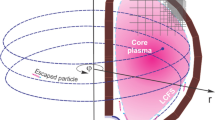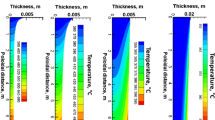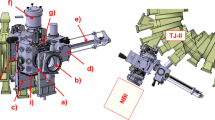Abstract
The divertor technology has become the focus of concern for prospective steady state tokamak reactors. The imposed heat flux and particle flux conditions cast doubt on the feasibility of any solid surface divertor. The aim of this work is to evaluate the existing concepts of liquid metal divertors from the physics, engineering, and safety points of view. Lithium metal is found to relatively suffer from a large tritium inventory that may develop in the form of solid hydride LiH, in addition to the fire hazard potential. Gallium does not form hydride within the temperature range of interest and is inactive with oxygen, therefore it is considered a more favorable metal. The flowing film and pool type divertors are found to suffer from the possible blistering erosion and resulting plasma contamination. The self-cooled liquid metal film divertor suffers also from a linear MHD instability, in addition to complicating factors such as the variation of the liquid metal electric property, dynamics of halo current, and the possible incompatibility with the insulator coating. The liquid gallium droplet curtain divertor appears to be the most feasible and roust, but its high temperature vapor is corrosive to most structural materials.
Similar content being viewed by others
References
D. E. Postet al. (1991). ITER physics.IAEA 21.
C. P. Liao, M. S. Kazimi, B. LaBombard, and B. Lane (1992). On modeling of plasma edge conditions at divertors with solid metal neutralizers.Fusion Technol. 21, 41.
T. J. Dolan (1982).Fusion Research (Pergamon Press, New York), p. 728.
B. L. Doyle and D. K. Brice (1984). Steady state hydrogen transport in solids exposed to fusion reactor plasmas, Part II: Application of theory.J. Nucl. Mater. 123/123, 1523.
G. M. McCracken and S. K. Erets. Ion Burial in the Divertor of a Fusion Reactor, B.N.E.S. Nuclear Fusion Reactor Conference, Culham Lab., September 1969.
C. P. Liao, M. S. Kazimi, and J. Meyer (1993). On hydrogen transport and edge plasma modeling of liquid metal divertors.Fusion Technol. 23, 108.
N. A. Galaktionowa (1980).Hydrogen-Metal Systems Databook (Ordentlich).
D. L. Smith. et al. Proc. 9th symp. on engineering problems of fusion research (Chicago, 1981), Institute of Electrical and Electronics Engineers, N.Y., 1982, p. 719.
E. V. Murav'ev. Liquid Metal Droplet Heat Removal System for ITER Divertor, Working Material to ITER June–October 1989 Session, Garching, Germany, 1989.
C. P. Liao, M. S. Kazimi, and B. LaBombard. MHD Effects on Liquid Metal Film Flow, Proceedings of the Fifth International Topical Meeting on Reactor Thermal Hydraulics, Vol. IV, Sept. 21–24, Salt Lake City, Utah, 1992, pp. 1089–1096.
T. N. Aitov, A. B. Ivanov, and A. V. Tananaev (1987). Flow of liquid metal in a coplanar magnetic field.Magnetohydrodynamics 2, 78.
I. A. Sheka et al. (1966).The Chemistry of Gallium (Elsevier Publishing, New York).
D. R. Lide (1992).Handbook of Chemistry and Physics, 73rd Ed. (CRC Press, Ann Arbor).
C. P. Laio and M. S. Kazimi (1992). A feasibility assessment of liquid metal divertors.Fusion Technol. 21, 1845.
D. T. Hurd (1952).Chemistry of the Hydrides (John Wiley & Son, New York).
Author information
Authors and Affiliations
Rights and permissions
About this article
Cite this article
Liao, C., Kazimi, M.S. On the design of liquid metal divertors. J Fusion Energ 13, 33–38 (1994). https://doi.org/10.1007/BF02214046
Issue Date:
DOI: https://doi.org/10.1007/BF02214046




